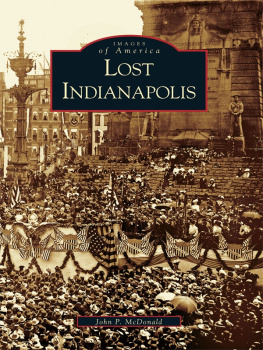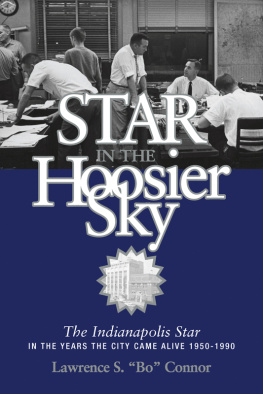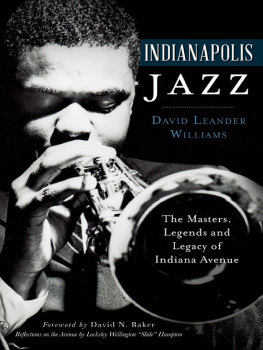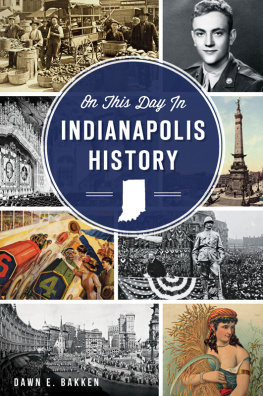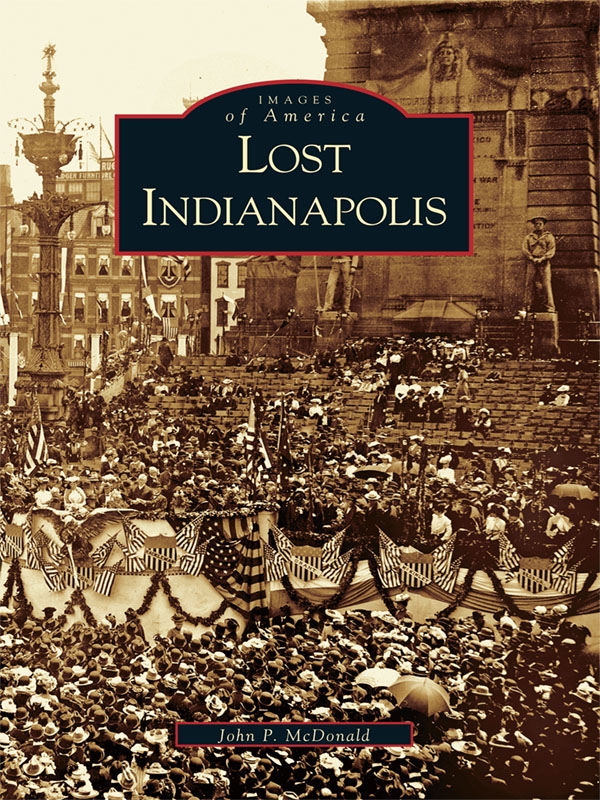The author gratefully acknowledges the help of many individuals and resources, including:
These stories are drawn from information in the Indianapolis Star and Indianapolis News , from Encyclopedia of Indianapolis , from eyewitness accounts, and from the Internet.
BIBLIOGRAPHY
COLLECTIONS
Indiana Historical Society Library, Indianapolis, Indiana. Claypool Hotel Records 18851952.
Indiana Historical Society Library, Indianapolis, Indiana. L.S. Ayres and Company Records 18581992.
Indiana Historical Society Library, Indianapolis, Indiana. W.H. Bass Photo Company Collection.
BOOKS
Bodenhamer, David J. and Robert G Barrows. Encyclopedia of Indianapolis . Indianapolis, Indiana: Indiana University Press, 1994.
Fadely, James P. and Philip J Fadely. Thomas Taggart: Public Servant, Political Boss 18561929 . Indianapolis, Indiana: Indiana Historical Society, 1997.
Fisher, Jerry M. The Pacesetter: The Untold Story of Carl G. Fisher . Fort Bragg, California: Lost Coast Press, 1988.
Hetherington, James R. Indianapolis Union Station: Trains, Travellers, and Changing Times. Carmel, Indiana: Guild Press of Indiana, 2000.
Lugar, Richard G. Indianapolis: Crossroads Of The American Dream . Memphis, Tennessee: Towery Publishing, 1996.
Nye, Charlie and Joe Young. Hoosier Century . Champaign, Illinois: Sports Publishing, 1999.
GOVERNMENT DOCUMENTS
Indianapolis Historic Preservation Commission, City of Indianapolis, Marion County, Indiana, Woodruff Place Historic Area Preservation Plan , September 5, 2001.
INTERNET RESOURCES
Pacers close Market Square Arena tonight, The Sporting News , October 22, 1999 http://www.sportingnews.com/nba/articles/19991105/187723-p.html
A Brief Commentary on the Central Canal, Canal Society of Indiana, September 20, 2001. http://www.indcanal.org/Central_Canal.html
NEWSPAPER ARTICLES
3-2-1The Implosion of Market Square Arena, Indianapolis Star , July 9, 2001.
Amateur Sleuths Uncovering Ill-Fated Central Canal Story, Indianapolis Star , September 24, 2001.
Glimpses of the Past: Pieces of Indianapolis History are Put on the Auction Block, Indianapolis Star , September 26, 2001.
Police Baffled By Kidnappings, Indianapolis Star , November 19, 1979.
The Ripple Effect, Indianapolis Star , September 2, 2001.
MAGAZINE ARTICLE
Bulletin 91Indiana Railroad System, Trolley Sparks, The Central Electric Railfans Association, 1950.
UNPUBLISHED MANUSCRIPT
Gibbs, Nathan. The Oral History of Frank Porter Thomas Jr., transcribed from 1/10/961/36 in Taos, New Mexico.
Find more books like this at
www.imagesofamerica.com
Search for your hometown history, your old
stomping grounds, and even your favorite sports team.
One
THE CENTRAL CANAL
Governor Noah Noble is remembered for two things: the fact that residents named Noblesville for him, and that on January 27, 1836, he signed a law that would issue bonds to build a transportation infrastructure for the new State of Indiana. Unfortunately, only one of these two things would work out well: Noblesville lives on, but by 1839, the state would go bankrupt under the crushing debt generated by the transportation program.
In Noahs day, politicians put much thought into ways to connect landlocked towns and cities to the rest of America. There were two competing technologies: railroads, which were still new and unorganized, and canals, which would create shipping lanes linked to major rivers and waterways. In 1825, the Erie Canal was completed, and its success caused many states to jump onto the canal bandwagon and plan ambitious projects of their own. The process for choosing the path of a railroad or a canal was often highly political, with legislators looking to bring home something for their constituents.
The Indiana project was no different, except that rather than attempt to choose between the two technologies, they decided to pursue both. Ignoring economic realities, the bond issue authorized by the governor on that day was set up to fund all projects simultaneously. Anxious to get started, politicians returned home to begin building their part of the systemand many small projects along the paths began all at once.
The Central Canal was to be a major part of Indianas new canal system, linking the Wabash and Erie Canal to the Cross-Cut Canal, creating a pathway across the state that would link the Ohio River to Lake Erie and beyond. Work began on several sections at once, with the primary digging occurring in the middle portion of the Central Canal, or the Indianapolis division, among other reasons to show lawmakers that progress was occurring on their plan.
The dig, which was about 24 miles in length, began at Broad Ripple and ended at Port Royal, a lost town near Waverly, Indiana. By early 1839, the first section from Broad Ripple south to a creek called Pleasant Run opened, with water tapped from the White River northeast of Broad Ripple. Almost immediately, businesses sprang up along its banks, using the flowing water as power for milling and machinery. A small amount of transportation traffic started, mostly moving goods up and down the path from business to business, as well as some recreational traffic.
Soon, though, financial disaster struck and work stopped. Other parts of the Central Canal crawled north from Evansville, eventually becoming part of the reworked Wabash and Erie Canal. Most other sections were filled in. By 1850, the legislature ordered the completed and watered portion through Marion County sold, as it was losing money in its operation. After passing through a series of private owners, it was finally handed over to the Indianapolis Water Company who used it to power turbines that pumped water to its customers. Throughout the century, residents strolled along parts of the canal north of downtown, while the section of canal in the city would at times become an open sewer.
By the 1960s, construction of the downtown interstate system forced some of the flowing water underground where it emerged on the west side of downtown to flow for some distance towards the White River. In the mid-1970s, the Indianapolis Water Company turned over the section south of Sixteenth Street to the city for a revitalization project that saw the canal re-dredged and lined with concrete. This new canal project marked one of the first major downtown beautification projects, which in turn stimulated growth of new residential and retail buildings along its path. The redeveloped downtown canal now winds its way through part of the White River State Park, with memorials and museums lining its banks.
The northern portion near Broad Ripple remains much as it was when it was first dug, complete with towpaths along its edge. The source of the canal is still on the east side of Westfield Boulevard north of Broad Ripple Avenue. The canal flows southwest under several bridges behind the rows of shops to emerge on the west side of College Avenue and run along Westfield Boulevard to the southwest. Along with its redeveloped counterpart downtown, these sections of the Central Canal remain easily visible, if unnoticed as residents hurry about their daily lives.

